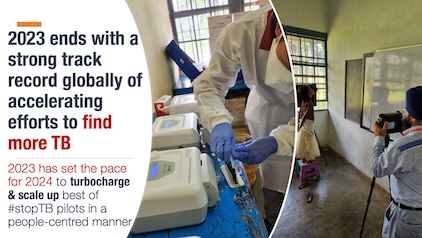Quantum of solace in efforts to find all TB but glaring gaps remain
SHOBHA SHUKLA, BOBBY RAMAKANT - CNS
As the year 2023 comes to an end, it is indeed a quantum of solace moment in terms of finding all TB worldwide. Globally we could find a record number of new TB cases in a single year - historically. Over 7.5 million new TB cases were diagnosed in 2022 worldwide - highest ever in the age-old fight against TB (as per the latest Global TB Report of the UN health agency, the World Health Organization (WHO) that was released in November 2023).
Finding more TB cases is an important benchmark but not able to find all TB cases continues to be worrisome. Out of the 10.6 million estimated people with TB, we at best have reached out to 7.5 million people so far in 2022.
That is why WHO's highest level initiative - Find.Treat.All (first launched in 2018) - had called upon all governments to replace the old and poorly performing microscopy TB test with WHO-recommended rapid molecular tests by 2027. World leaders at the 2023 UN High Level Meeting on TB had also re-echoed this call to completely phase out microscopy with upfront molecular test diagnosis for TB by 2027.
While we cheer those who have worked hard to find most TB in a single year historically, we also need to realise that we could have done much better.
Of the 7.5 million new people who were diagnosed with TB in 2022, only 47% were diagnosed using a WHO-recommended molecular test. In other words, more than half of them got the underperforming and outdated microscopy test. This is so unacceptable as we cannot afford to miss TB.
Three important records set in India
India, which carries the highest TB burden globally, set three important records in 2022 as per the government's India TB Reports of 2022 and 2023.
Record-1
First, the good record. India saw the largest-ever rollout of WHO-recommended molecular tests across the nation. Lessons learnt in India's rollout of molecular testing upfront for finding TB will be an important guiding light for so many more high TB burden nations.
Two Indian states (Goa and Lakshadweep) have completely phased out microscopy and transitioned to 100% use of molecular tests while one Indian state (Andhra Pradesh) is majorly using molecular tests (~70%) and has reduced microscopy. Most of the other Indian states have also increased the use of molecular tests manifold and are at different levels of scaling it up (but are they phasing out microscopy?).
Record-2
Second, the not-so-good record. While the use of molecular testing has seen a rapid rise, the country also increased (not decreased) the use of microscopy for finding TB to a record level in 2022. Over 13.9 million microscopy tests were done in 2022 in India (a record so far) as compared to 8.9 million such tests done in 2021 for finding TB. Earlier in 2018, India had recorded its previous high use of microscopy at 12.1 million.
Numbers do not always tell the full story
As per the WHO Global TB Reports, the use of upfront molecular tests in diagnosing TB rose globally from 38% in 2021 to 47% in 2022 - an increase of 9%. In India, the use of molecular tests grew from 22.4% in 2021 to 23% in 2022 - an increase of 0.6% - but the number 0.6% does not tell the real story. Let's dive a bit deeper.
Molecular testing grew by 82% in India in 2022 as compared to the levels in 2021 - this is the largest jump in molecular testing figures so far. But this feat is not reflected in the figure of "0.6%" (22.4% to 23% increase during 2021-2022) when we compare the number of molecular tests done with the overall use of TB testing in the country in 2021 and 2022. This is because the creditable increase in molecular testing was offset by the meteoric rise in microscopy also. Microscopy should have reduced and not increased (both - in terms of proportion and numbers)! Thus, during 2021-22 the use of molecular tests in India grew at a record pace, but the growth in microscopy was the steepest in 2022.
As compared to 2021, in 2022 India increased the rollout of WHO-recommended point-of-care, decentralised and laboratory independent molecular test Truenat by 90% (made by Molbio Diagnostics), and WHO-recommended molecular test (which requires semi-centralised infrastructure) Gene Xpert by 67% (made by Cepheid). Microscopy increased during the same period by 68.1%. But when we look at absolute numbers, the rise in microscopy dwarfs the historic scale up of molecular testing in India in 2022. Nearly 5.5 million more microscopy was done to find TB in 2022 compared to 2021. Whereas molecular testing for finding TB grew by almost 2 million in 2022 in India. Truenat is the largest used molecular test in India.
While the historic increase in molecular testing in India is a major public health achievement but, on the other hand, a steep increase in microscopy sparks serious concerns.
Neither science nor public health rationale will perhaps justify the increasing use of microscopy as a diagnostic test for TB when WHO recommended molecular tests exist. What does not exist is a proven track record globally to translate scientific breakthroughs into public health gains in a timely manner. If we can ensure that WHO recommended molecular tests are globally used upfront for every person with presumptive TB then when new TB tools come out of research and development pipeline (such as TB vaccine) in foreseeable future, we would have learned the pathway to reach the unreached. But as of now, this is not the case. Rollout of the new health technologies (including COVID-19 vaccines) is marred with inequity. Making molecular TB testing available to all with presumptive TB will accelerate efforts to find all TB and link all of them to proper TB care cascade (and thus end TB). It is also an opportunity for the world leaders to walk the talk on equitable rollout of health technologies.
(Note: You can view every article as one long page if you sign up as an Advocate Member, or higher).






